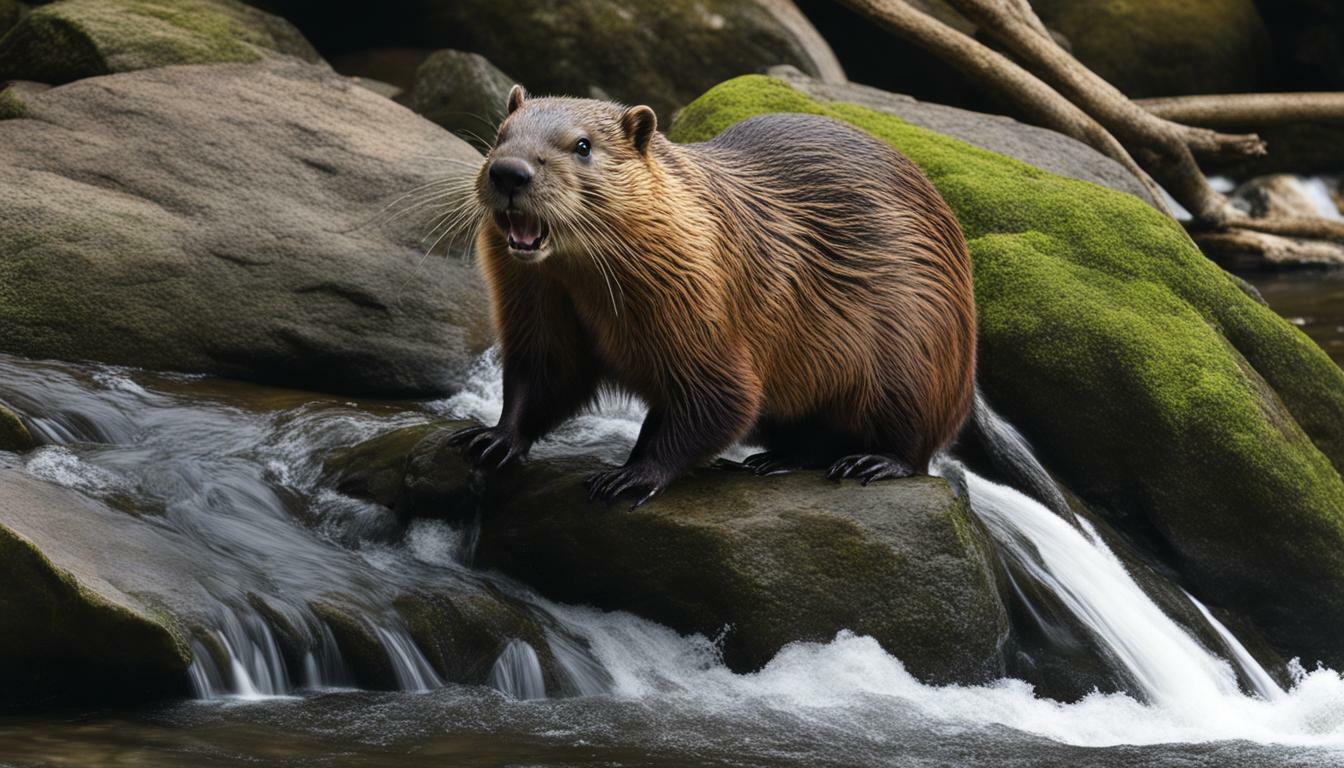Have you ever wondered why beavers seem to have a strong aversion to running water? These fascinating creatures exhibit unique behavior when it comes to their interaction with water. Beavers hate running water because they perceive it as a sign of structural damage to their dams. Instead, they prefer a quiet, undisturbed environment where no water is passing through. In this article, we will explore the reasons behind beavers’ aversion to running water and their behavior as dam-building mammals.
Key Takeaways:
- Beavers hate running water because they perceive it as a sign of structural damage to their dams.
- The louder the sound of running water, the more urgent it becomes for beavers to fix the leak.
- Beavers judge the success of their repairs based on how much quieter the water becomes.
- Beavers are prompt to make necessary repairs and inspect their dams daily for leaks.
- Beaver dams have important ecological benefits, providing protection and habitats for various animal species.
Understanding Beaver Behavior
Beavers, as water-loving animals, have unique behaviors that make them exceptional in their aquatic environments. Their ability to construct intricate dams and manipulate their surroundings is a testament to their ingenuity and adaptability. Let’s explore some fascinating aspects of their behavior that help them thrive in their watery habitats.
Building Impressive Dams
One of the most remarkable behaviors of beavers is their innate skill in dam building. Using a combination of natural materials such as mud, sticks, rocks, and vegetation, they create structures that can span across rivers and create new waterways. Beavers meticulously construct watertight dams to create calm, quiet ponds above the dam, which they use as their habitat.
Inspecting and Repairing Leaks
Beavers are diligent creatures, diligently inspecting their dams daily for any signs of damage or leaks. The sound of running water is particularly bothersome to them, as they perceive it as a sign of structural damage. The louder the sound, the more urgent it becomes for beavers to fix the leaks. They judge the success of their repairs based on the decrease in the sound of running water, striving for a perfectly quiet dam.
Ecological Benefits of Beaver Dams
Beaver dams play a crucial role in the ecosystem by creating habitats for a variety of animal species. These dams provide a safe haven for beavers themselves, protecting them from predators. Additionally, the calm ponds created above the dams serve as a water source for many other creatures. The slow-moving water also helps filter out impurities, contributing to water cleansing. Furthermore, beaver dams can regulate water levels and prevent flooding, making them vital for maintaining a balanced ecosystem.
| Benefits of Beaver Dams: | |
|---|---|
| Flood control | Preventive measure against flooding |
| Water cleansing | Help filter impurities and improve water quality |
| Habitat creation | Provide shelter for various animal species |
While beaver dams offer numerous ecological benefits, it’s important to note that they can also have downsides if they break. Flooding and damage to nearby property and infrastructure can occur when the water flow is disrupted. Despite this potential risk, it is undeniable that beavers and their remarkable behaviors greatly contribute to the intricate web of life in aquatic ecosystems.
The Perception of Structural Damage
Beavers consider a perfect dam to be one that is quiet, with no water passing through, and any sound of running water can trigger their alarms. This aversion to running water is rooted in their perception of it as a sign of structural damage to their meticulously constructed dams. For beavers, the sound of water flowing signifies a potential breach in their defenses, which prompts them to take immediate action.
When beavers hear the sound of running water, they interpret it as a call to fix any leaks that may have appeared in their dam. Their urgency to address these leaks stems from their instinct to maintain the integrity of their habitat, ensuring the safety of their lodge and food supply. The louder the sound of running water, the more urgent it becomes for the beavers to locate and repair the leak.
Beavers judge the success of their repairs by the decrease in the sound of running water. Their goal is to create a dam that is watertight, minimizing the flow of water and maintaining a peaceful, serene environment within their lodge. The quieter the dam, the more content the beavers are, knowing they have successfully sealed off any potential threats.
| Perception of Structural Damage: | Beavers perceive running water as a sign of structural damage. |
|---|---|
| Urgency to Fix Leaks: | The sound of running water triggers beavers to promptly repair any leaks. |
| Success Metric: | Beavers judge the success of their repairs based on the decrease in the sound of running water. |
Urgency to Fix Leaks
The louder the sound of running water, the more urgent it becomes for beavers to fix the potential breach in their dam. Beavers have an aversion to running water because they perceive it as a sign of structural damage to their meticulously constructed dams. They consider a perfect dam to be quiet, with no water passing through. So when they hear the sound of running water, it triggers their instincts to quickly repair any leaks and restore the integrity of their dam.
Beavers are prompt to make any necessary repairs and go out daily to inspect their dams for leaks. They understand that even a small breach can lead to significant problems if left unattended. With their keen sense of hearing, they can quickly locate the source of the running water and get to work on fixing it. Their urgency stems from the need to maintain their ideal living environment and protect their habitat from potential flooding and damage.
To repair the leaks, beavers use their impressive building skills and environmental adaptations. They gather materials such as mud, sticks, rocks, and vegetation to create watertight patches that seal the breach. As they work on the repairs, they judge the success of their efforts by how much quieter the water becomes. A decrease in the sound of running water indicates that the leaks are being effectively sealed, giving the beavers a sense of accomplishment and reassurance that their dam is secure.
| Beaver Dam Construction | Aversion to Running Water |
|---|---|
| Beavers gather materials such as mud, sticks, rocks, and vegetation to construct their dams. | Running water is perceived as a sign of structural damage to their dams. |
| Their dams help protect them from predators and provide access to food. | The louder the sound of running water, the more urgent it becomes for beavers to fix the breach. |
| The construction of their dams has ecological benefits such as flood control and water cleansing. | Beavers go out daily to inspect their dams for leaks and make necessary repairs. |
| However, if the dam breaks, it can cause flooding and damage to nearby property and infrastructure. | Beavers judge the success of their repairs by the decrease in the sound of running water. |
Daily Inspections
Beavers have a proactive approach to maintaining their dams, going out daily to inspect for any vulnerabilities or leaks. This diligent behavior is crucial to their survival and the long-term stability of their habitats. When inspecting their dams, beavers pay close attention to the sound of running water, as it is a clear indicator of potential damage.
By actively listening for the sound of running water, beavers can quickly identify any leaks or breaches in their dams. They have an acute sense of hearing, which allows them to detect even the faintest sounds of water flowing. If they hear an increase in the volume or intensity of running water, it signals to them that there may be a leak that needs immediate attention.
To fix leaks, beavers use a combination of mud, sticks, rocks, and vegetation. They meticulously patch up any openings or weak spots in the dam to restore its structural integrity. Beavers work tirelessly, day and night, to ensure that their dams remain watertight and secure.
| Key Points: |
|---|
| Beavers inspect their dams daily. |
| They listen for the sound of running water as a sign of potential damage. |
| Beavers use mud, sticks, rocks, and vegetation to fix any leaks or vulnerabilities in the dam. |
The Success Metric
Beavers assess the effectiveness of their repairs based on how much quieter the water becomes after fixing the leaks. For these meticulous dam builders, a perfect dam is one that is quiet, with no sound of running water passing through. The louder the sound of water, the more urgent it becomes for the beavers to locate and repair the leak.
Regular inspections are an essential part of a beaver’s routine. These diligent creatures go out daily to inspect their dams, searching for any signs of damage or leaks. When they find a leak, they waste no time in making the necessary repairs, ensuring that their dams remain intact and watertight. By fixing the leak, the beavers strive to achieve a quieter dam, signaling the success of their repairs.
In their construction efforts, beavers demonstrate remarkable skill and resourcefulness. They use a combination of materials, including mud, sticks, rocks, and vegetation, to create watertight dams. The strategic placement of these materials, along with their intricate weaving techniques, helps beavers reinforce their dams, making them resistant to the force of running water.
| Beaver Dam Building Materials | Advantages |
|---|---|
| Mud | Acts as a sealant to prevent water from seeping through |
| Sticks | Provides structural support to the dam |
| Rocks | Increases the stability and strength of the dam |
| Vegetation | Improves the dam’s ability to withstand water pressure |
The importance of beaver dams extends beyond their immediate benefit to the beavers themselves. These remarkable structures serve as vital components of the ecosystem, offering protection from predators and creating habitats for a wide range of animal species. Furthermore, the dams have ecological benefits such as flood control, water cleansing, and the provision of food sources for various organisms.
However, it is worth noting that beaver dams can also have a destructive potential. If these dams were to break, they could cause flooding and damage to nearby property and infrastructure. As such, striking a balance between the positive contributions of beaver dams and managing potential risks is crucial for maintaining a healthy ecosystem.
Importance of Beaver Dams
Beaver dams play a crucial role in the ecosystem, providing protection from predators and creating diverse habitats for various species. These remarkable structures are more than just barriers in a stream; they are complex systems that have a profound impact on the surrounding environment.
- Protection: Beaver dams create calm, stagnant areas of water behind them, which serve as safe havens for beavers and other aquatic wildlife. These areas offer protection from predators and strong currents, allowing animals to thrive and reproduce in a secure environment.
- Diverse Habitats: The creation of beaver dams leads to the formation of wetlands, which are incredibly diverse ecosystems. Wetlands are home to a wide range of plant and animal species, including waterfowl, amphibians, and insects. They serve as breeding grounds and provide abundant food sources, contributing to the overall biodiversity of the area.
- Flood Control: Beaver dams also play a vital role in flood control. By trapping water behind their structures, beavers can slow down the flow of water during periods of heavy rain or snowmelt. This helps to prevent downstream flooding and allows the surrounding land to absorb water more gradually.
- Water Cleansing: The intricate network of beaver dams and wetlands acts as natural filters, purifying the water as it passes through. The plants and vegetation in these areas help to remove pollutants and excess nutrients, improving the overall water quality for other organisms downstream.
Ecological Benefits
The ecological benefits of beaver dams extend beyond their immediate surroundings. By creating wetlands and altering the hydrology of the landscape, beavers contribute to the health and balance of entire ecosystems. Their activities enhance habitat connectivity, provide resources for other species, and support the delicate web of life.
| Benefits of Beaver Dams | Examples |
|---|---|
| Flood Control | Preventing downstream flooding by slowing down water flow |
| Biodiversity | Creating diverse habitats for various plant and animal species |
| Water Quality | Purifying water by filtering pollutants and excess nutrients |
| Carbon Sequestration | Storing carbon in wetland soils, mitigating climate change |
Beaver dams are a testament to the incredible adaptability and environmental impact of these industrious creatures. Their construction efforts shape landscapes, promote biodiversity, and contribute to the overall health of our ecosystems. Understanding and appreciating the importance of beaver dams can help us better coexist with these remarkable animals and protect their habitats for generations to come.
Skilled Builders
Beavers are skilled builders, utilizing mud, sticks, rocks, and vegetation to meticulously construct their dams. Their construction process involves a combination of engineering principles and innate environmental adaptations. By strategically placing these materials, beavers create a watertight barrier that not only helps to control water flow but also provides a safe and secure habitat for themselves and other species.
These industrious creatures start by selecting a suitable location, typically a flowing stream or river, where they can utilize the force of running water to their advantage. They begin by constructing a framework using sturdy sticks and logs, creating a solid foundation for the dam. To seal any possible leaks, they carefully pack mud and plant materials into the gaps between the sticks, ensuring a tight and secure structure.
As the dam takes shape, beavers reinforce it further by incorporating rocks into the design. These rocks help to anchor the dam in place, preventing erosion and enhancing its overall strength. Additionally, the beavers incorporate vegetation, such as branches and leaves, which act as natural filters, helping to trap sediment and improve water quality within the dammed area.
| Materials Used by Beavers for Dam Construction | Environmental Adaptations |
|---|---|
| Mud | Provides a watertight seal, preventing leaks |
| Sticks and Logs | Creates a sturdy framework for the dam |
| Rocks | Anchors the dam, preventing erosion |
| Vegetation | Acts as a natural filter, improving water quality |
The construction of beaver dams showcases their remarkable ability to adapt to their environment and manipulate it to suit their needs. Through their skilled craftsmanship, beavers create not only a home for themselves but also a valuable ecosystem that provides numerous ecological benefits, including flood control, water purification, and the creation of diverse habitats for various animal species.
Ecological Benefits
The dams built by beavers offer various ecological benefits, including flood control, water cleansing, and the creation of diverse habitats. Beavers, known as dam-building mammals, play a critical role in shaping and maintaining ecosystems. Let’s explore how their remarkable engineering abilities contribute to the environment.
One of the significant benefits of beaver dams is their ability to control flooding. By building dams across streams and rivers, beavers create reservoirs that can absorb and retain large amounts of water during heavy rainfall. This helps regulate water flow downstream, reducing the risk of flooding in surrounding areas.
In addition to flood control, beaver dams also contribute to water cleansing. The structure of the dams traps sediment, organic matter, and pollutants, acting as a natural filtration system. As water passes through the dam, it becomes cleaner and clearer, benefiting not only the beavers but also other aquatic organisms that rely on clean water for survival.
The creation of diverse habitats is yet another ecological benefit of beaver dams. The dams create ponds and wetlands, which become crucial habitats for various animal species. These habitats provide shelter and abundant food sources for amphibians, fish, waterfowl, and other wildlife. The diverse vegetation that grows around these habitats further enhances biodiversity, attracting a wide range of species.
| Ecological Benefits of Beaver Dams |
|---|
| 1. Flood control |
| 2. Water cleansing |
| 3. Creation of diverse habitats |
In summary, beaver dams have significant ecological benefits. They help control flooding, contribute to water cleansing, and create diverse habitats for various animal species. These benefits highlight the crucial role that beavers play as ecosystem engineers, shaping and maintaining habitats that support a thriving ecosystem.
Destructive Potential
While beaver dams bring many benefits, their failure can lead to flooding and damage to nearby infrastructure and property. These impressive structures, built with skill and precision, are designed to create a still and tranquil environment. However, if a beaver dam breaks or becomes compromised, it can unleash a powerful rush of water, causing significant destruction.
Beaver dams are constructed using a combination of natural materials, such as mud, sticks, rocks, and vegetation, carefully woven together to create a watertight barrier. This barrier helps to control water flow, regulate water levels, and prevent excessive erosion in aquatic ecosystems.
When a beaver dam breaks, it can result in a surge of water that overwhelms surrounding areas, leading to flooding. This flooding poses a threat to nearby infrastructure, including roads, buildings, and agricultural land. The force of the water can erode soil, wash away vegetation, and cause damage to property, disrupting human activities and affecting the delicate balance of the ecosystem.
Table: Examples of the Potential Damage Caused by Beaver Dam Failure
| Damage | Impact |
|---|---|
| Structural damage to buildings | Compromising the integrity of homes and other structures |
| Flooding of agricultural land | Destroying crops, soil erosion, and loss of livelihood |
| Erosion of riverbanks | Undermining stability, leading to landslides and property damage |
| Disruption to natural habitats | Endangering the survival of local wildlife species |
Preventing and managing potential damage caused by beaver dam failures involves careful monitoring and maintenance. It requires a delicate balance between preserving the positive ecological impacts of beaver dams and minimizing the risks to human infrastructure and property. Strategies such as controlled dam removal and the implementation of alternative water flow management techniques can help mitigate the destructive potential of beaver dam failures while preserving the vital role these fascinating creatures play in the environment.
Beavers’ Impact on the Environment
Beavers, as ecosystem engineers, have a significant impact on the environment through their dam-building behavior. By constructing intricate dams, these industrious animals create a multitude of ecological benefits. Their dams act as a natural flood control mechanism, helping to regulate water levels and prevent excessive runoff during periods of heavy rain or snowmelt.
Not only do beaver dams provide flood control, but they also play a vital role in water cleansing. The slow-moving water behind these dams allows sediment and pollutants to settle, resulting in cleaner water downstream. This is especially important for maintaining the health and quality of aquatic ecosystems and the species that rely on them.
Furthermore, beaver dams create diverse habitats for a wide range of animal species. The calm, shallow water created by these structures attracts various aquatic creatures, including fish, amphibians, and invertebrates. Additionally, the surrounding wetlands and the abundance of vegetation near the dams provide foraging areas and shelter for numerous bird species and small mammals.
| Ecological Benefits of Beaver Dams | |
|---|---|
| Flood control | Regulates water levels and prevents excessive runoff |
| Water cleansing | Sediment and pollutant removal, resulting in cleaner water downstream |
| Habitat creation | Provides diverse habitats for fish, amphibians, invertebrates, birds, and small mammals |
While beaver dams are crucial for maintaining ecosystem balance, they can also have a destructive potential if they were to break. If a dam fails, it can cause flooding and damage to nearby property and infrastructure, particularly in human-populated areas. Thus, it is important to strike a balance between appreciating the positive impacts of beavers and managing potential risks associated with their dam-building activities.
Conclusion
Beavers’ dislike of running water and their diligent dam-building behaviors make them fascinating creatures with a profound impact on their environment. These aquatic mammals perceive running water as a sign of structural damage to their dams, prompting them to urgently fix any leaks. They judge the success of their repairs by the decrease in the sound of running water, striving for a perfectly quiet dam.
Beavers are meticulous in their daily inspections, ensuring the integrity of their dams and searching for any signs of leakage. Their dams serve as crucial habitats, providing protection from predators and access to food for a variety of animal species. Through their skilled building techniques, using materials like mud, sticks, rocks, and vegetation, beavers construct watertight dams that have numerous ecological benefits.
These dams act as natural flood control measures, helping to regulate water levels and prevent potential disasters. They also play a vital role in water cleansing, filtering sediments and pollutants, and improving water quality. Additionally, beaver dams create diverse wetland habitats, supporting a wide range of plant and animal life, further enhancing the overall ecosystem.
However, there is a potential downside to beaver dams if they break, leading to flooding and damage to nearby property and infrastructure. It is essential to strike a balance between the benefits and potential risks associated with these remarkable dam-building mammals.
FAQ
Why do beavers hate running water?
Beavers perceive running water as a sign of structural damage to their dams, which they strive to keep quiet and watertight.
How do beavers judge the success of their dam repairs?
Beavers judge the success of their repairs based on how much quieter the water becomes after fixing any leaks in their dams.
Why are beavers prompt to fix any leaks in their dams?
The sound of running water triggers a sense of urgency for beavers to repair any leaks in their dams to maintain their preferred quiet environment.
Do beavers inspect their dams regularly?
Yes, beavers go out daily to inspect their dams for any signs of damage or leaks that may need immediate attention.
What materials do beavers use to construct their dams?
Beavers use materials such as mud, sticks, rocks, and vegetation to build watertight dams.
What are the ecological benefits of beaver dams?
Beaver dams provide flood control, water cleansing, and create habitats for various animal species, enhancing the overall ecosystem.
Can beaver dams be destructive?
Yes, if beaver dams break, they can cause flooding and damage to nearby property and infrastructure.




